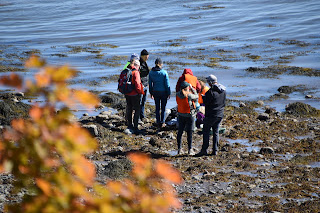This week on campus we hosted students from Adam Scott Collegiate Vocational Institute and Clarington Central Secondary School from the Kawartha Pine Ridge District School Board. The students were introduced to the local marine environment through field excursions and hands-on labs. Below are a few photos from our exciting week of learning!
Collecting data on the water temperature and salinity while on the research vessel, the Fundy Spray. The water temperature was about 12.5 Celsius. Brrrr!
Plankton collected on the boat and ready to be analyzed in the lab.
Drawing plankton.
Identifying the plankton species.
View of phytoplankton at 100x.
View of zooplankton & phytoplankton at 40x magnified. Lots of copepods!
Morning lab studying marine invertebrate classification.
Drawing and describing the live animals.
Using a dichotomous key and field guides to identify the animals.
Some of the animals collected by the students and used in the classification lab were an armoured shrimp, a scallop, a blood star,
a toad crab, a common sea star,
a sea anemone and a Stimpson's whelk.
The collected animals are kept for the week in tanks of flowing seawater that is pumped from the bay.
Beautiful feeding sea cucumber!
Right whale! The students had a great whale watching trip with Quoddy Link Marine. They were able to see all four large whale species that frequent the bay: right whale, humpback, fin and minke, as well as, harbour porpoise, harbour seals and grey seals. Here are a few updates, photos and videos from the Quoddy Link Facebook page:
1,
2,
3 &
4.
A presentation in the theatre about the amazing life cycle of lobsters. Do you know how to tell if a lobster is a lefty or a righty?
Studying the external anatomy of sea urchins.
View through the microscope. You can see the green spines, the purple tube feet, and a few white pedicellariae (pincers).
Learning how to handle the animals properly.
One of the sea urchins caused quite a stir when it started releasing sperm into the water during the lab!
Here is a view at 400x!
Behaviour lab: how does temperature affect the feeding rate of barnacles?
Students had to count the number of times the cirri extended in temperatures ranging from 5 - 25 Celsius.
Behaviour lab: does size affect the flipping rate of sea stars?
Some groups also looked at the flipping rate of different sized sea urchins.
Exploring the intertidal zone at low tide.
Students found rock gunnel fish!
Lots of animals hiding under the rocks, including sea stars.
The students also found lots of green crabs.
Last morning in the lab. Making dichotomous keys of seaweed collected on Grand Manan Island.
Observing the diversity of seaweeds.





























































